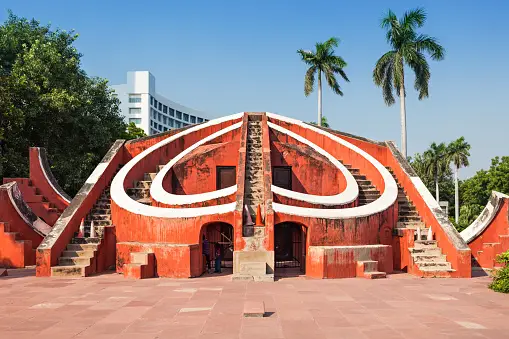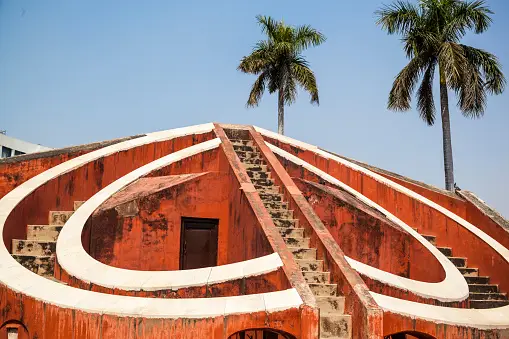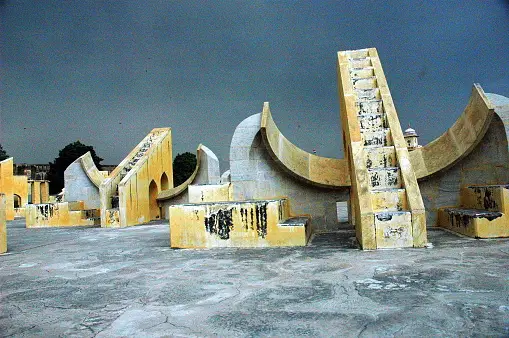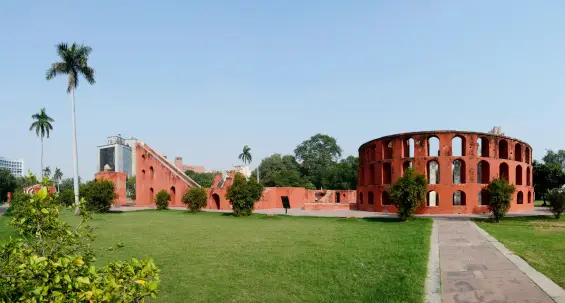Jantar Mantar, Delhi, Information, Entry Fee, History, Timing, Facts
- Mohit Kumar
- Aug 31, 2023
- 6 min read
Updated: Oct 30, 2023
Hello buddies drink to my new blog moment trip is we told his Jantar Mantar in New Delhi and Jantar Mantar Delhi ( Entry Fee, Timings, History, erected by, Images & position) that his truly beautiful place it's Jantar Mantar.

About of Jantar Mantar
The overlook consists of 13 architectural astronomical instruments, which were used to measure time, and the positions of the sun, moon, globes, and stars. The instruments are made of gravestones and essence, and some of them are relatively large.
The largest instrument in Jantar Mantar is the Samrat Yantra, which is a chronograph. It's 73 bases( 22 measures) altitudinous and can cast a shadow that's 236 bases( 72 measures) long. The Samrat Yantra can be used to measure time with a delicacy of over two seconds.
Jantar Mantar is an overlook located in New Delhi, India. It's one of the five lookouts erected by Maharaja Jai Singh II of Jaipur, a famed astronomer and sovereign of the Rajput state of Jaipur, during the 18th century. Jantar Mantar, Delhi, Information, Entry Fee, History,
Jantar Mantar is a popular sightseeing destination, and it's also used for educational purposes. The overlook is open to the public and there are guided tenures available. the overlook was constructed to make accurate astronomical compliances and measures, primarily of Elysian bodies like the sun, moon, and globes.

Jantar Mantar in New Delhi is specifically known as" Jantar Mantar, New Delhi" to distinguish it from the other lookouts erected by Maharaja Jai Singh II in Jaipur, Varanasi, Mathura, and Ujjain. It's positioned in the heart of the megacity, near Connaught Place, and is a popular sightseer magnet due to its literal and architectural significance.
Jantar Mantar includes the Jai Prakash Yantra, which is a hemispherical astrolabe; the Ram Yantra, which is a gnomon; and the Yantra, which is a combination of several instruments. The instruments at Jantar Mantar are fascinating for their imagination, but accurate compliances can no longer be made from them because of the altitudinous structures around them.
History of Jantar Mantar
Maharaja Jai Singh II was deeply interested in astronomy and mathematics, and he asked to produce accurate tools for observing Elysian bodies and conducting colorful astronomical computations. He constructed five Jantar Mantar lookouts in different locales across northern India
The Jantar Mantar in Delhi is the oldest and most notorious of these lookouts. It was completed in 1724 and contains a range of large masonry instruments used for measuring time, tracking the positions of Elysian objects, and prognosticating declines.
Varanasi The Varanasi overlook, erected in 1737, features instruments designed for observing the routeways of globes and stars. It includes the Chakra Yantra and the Dhruva Yantra, among others. this is the first of the five Jantar Mantar erected by Maharaja Jai Singh II. It's located in the Jantar Mantar complex in New Delhi.
The Jantar Mantar( Located in the center of New Delhi), is visited by excursionists, experimenters, and scholars from India and abroad. This is a literal monument with huge instrument structures of structure size.
The Jantar Mantar in Mathura is the least well-saved of the five lookouts. It was erected in 1740 and contains instruments analogous to those set up in the other lookouts. erected in 1724 by Maharaja Jai Singh II of Jaipur, Jantar Mantar is one of the five astronomical lookouts erected by the king in Northern India. Its striking combinations of geometric forms have caught the attention of engineers, artists, and art chroniclers from around the world.
These lookouts weren't only used for astronomical compliances but also for carrying out scientific exploration and making accurate prognostications related to astronomy. still, with advancements in technology and the development of further sophisticated astronomical instruments, the significance of the Jantar Mantar lookouts lowered over time.
The instruments are in most cases huge structures. They're erected on a large scale so that the delicacy of readings can be attained. The Samrat Yantra, for case, which is a chronograph, can be used to tell the time to a delicacy of about two seconds in Jaipur's original time.1 It's considered the largest chronograph in the world. moment the main purpose of the overlook is to serve as a sightseer magnet.
The Jantar Mantar overlook in Delhi comprises 13 astronomical instruments of which four are primarily biased utmost of these instruments were designed by Maharaja Jai Singh.
Jantar Mantar erected in an open space area with a group of different instruments was used to study the movement of stars, moon, and Earth, the differences in duration between days and nights, and the seasonal change. It was also used to calculate the accurate original time using the huge masonry structure as an instrument like a chronograph.
The entry figure for Jantar Mantar in Delhi and Jaipur is as follows
Indians Rs. 15 per person
Foreign excursionists Rs. 200 per person
SAARC and BIMSTEC callersRs. 15 per person
scholars Rs. 5 per person for Indian scholars and Rs. 50 per person for foreign scholars
Camera Rs. 25 per person
videotape Rs. 50 per person
Jantar Mantar is open from 6:00 AM to 6:00 PM on all days of the week.
Entry figure
Indians INR 15
Non-Natives INR 200
scholars INR 5( Indian) and INR 50( Foreign)
Camera INR 25
videotape INR 50
The entry figure for children under the age of 5 is free.
The entry figure for elderly citizens above the age of 60 is half the regular price.
The camera and videotape charges are only applicable for still photography and videography, independently.
The entry figure for the light and sound show is separate and is charged at Rs. 50 per person for Indians and Rs. 100 per person for foreign excursionists.
How to stylish Timing visit Jantar Mantar
The stylish time to visit Jantar Mantar depends on your preference. However, also the early morning or late autumn hours are a good time to go If you want to avoid the crowds. However, also noon is a stylish time to visit, If you want to see the timekeepers in action.
Then a breakdown of the pros and cons of visiting Jantar Mantar at different times of day.
Morning The crowds are lower in the morning, and the timekeepers are easier to see in the early morning light. still, it can be chilly in the morning, so be sure to dress warmly.
Jantar Mantar is open from 6:00 AM to 6:00 PM on all days of the week. and stylish Jantar Mantar is open from 6AM to 6 PM on all days of the week. The last entry is at 530 PM.
Structures inside the Jantar Mantar Complex
The Jantar Mantar overlook in Delhi comprises of 13 astronomical instruments of which four are primarily biased utmost of these instruments were designed by Maharaja Jai Singh II. Then’s a description of each
Samrat Yantra
Also known as the Supreme Instrument, it stands as the main structure inside the overlook. This structure is 70 bases in height, 114 bases in length at the base, and 10 bases thick. It's a giant triangle-shaped chronograph with a hypotenuse that's 128 bases in length. This hypotenuse is placed resemblant to the axis of the Earth and is pointed towards the North Pole. On either side of the triangle, a quadrant exists which has ladders that indicate the seconds, twinkles, and hours.
Jayaprakash Yantra
This instrument comprises structures mimicking concave components that are marked on their hollow shells. Jayaprakash Yantra was used to align the position of the Sun and the stars in the sky.
Rama Yantra
This instrument has two large structures of spherical shapes and open covers. These structures help to determine the altitude of the stars grounded on the longitude and latitude of the Earth.
Misra Yantra
It consists of five different instruments which are used to find out the longest and the shortest days of the time. These instruments are known as the Dakshinottara Bhitti, Samrat, Niyat Chakra, Karka Rashi Valaya, and the Western Quadrant. Jantar Mantar, Delhi, Information, Entry Fee, History,
The Misra Yantra is also effective for determining the exact noon time. It's believed to be the only instrument in the Jantar Mantar that wasn't constructed by Maharaja Jai Singh
Free Download Image Jantar Mantar, Delhi
Lodestones near Jantar Mantar, Delhi
This age-old overlook that had formerly helped indeed the lords and emperors to learn about the stars and globes in the sky, The structure testifies to the fact that India had made big hops in the realm of wisdom indeed centuries agone. And while you're in the capital megacity, make sure to visit the other literal places in Delhi that recite its rich history and heritage.
Location of Jantar Mantar, Delhi
Position of Jantar Mantar in Delhi
Jantar Mantar Delhi position chart
Metro Station Patel Chowk( Yellow Line)
Opening Hours 600 AM to 600 PM( All days)
It includes the Chakra Yantra and the Dhruva Yantra, among others. this is the first of the five Jantar Mantar erected by Maharaja Jai Singh II. It's located in the Jantar Mantar complex in New Delhi.





































Comments